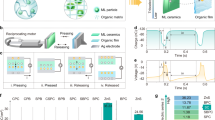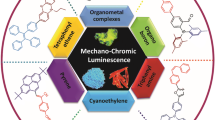Abstract
Mechanoluminescence (ML) has become the most promising material for broad applications in display and sensing devices, in which ZnS is the most commonly studied one due to its stable and highly repetitive ML performances. In this work, we have successfully prepared the biphase ZnS on a large scale through the facile in-air molten salt protection strategy. The obtained biphase has the best ML properties, which is mainly attributed to the synergistic effects of piezo-photonic, defect, and interface dislocations. DFT calculations have confirmed that the defects activate the local S and Zn sites and reduce the energy barrier for electron transfer. The much stronger X-ray induced luminescence than the commercial scintillator is also reached. The application of ZnS particles in both papers and inks delivers superior performance. Meanwhile, ZnS particles based screen printing ink is able to directly print on paper, plastic and other carriers to form clear marks. These proposed paper and ink hold great potentials in applications of information security and anti-counterfeiting based on the multi-mode luminescence properties. This work provides a new avenue to understand and realize the high-performance multi-mode luminescence, inspiring more future works to extend on other ML materials and boosting their practical applications.

Similar content being viewed by others
References
Wang, X. D.; Zhang, H. L.; Yu, R. M.; Dong, L.; Peng, D. F.; Zhang, A. H.; Zhang, Y.; Liu, H.; Pan, C. F.; Wang, Z. L. Dynamic pressure mapping of personalized handwriting by a flexible sensor matrix based on the mechanoluminescence process. Adv. Mater. 2015, 27, 2324–2331.
Zhang, J. C.; Pan, C.; Zhu, Y. F.; Zhao, L. Z.; He, H. W.; Liu, X. F.; Qiu, J. R. Achieving thermo-mechano-opto-responsive bitemporal colorful luminescence via multiplexing of dual lanthanides in piezoelectric particles and its multidimensional anticounterfeiting. Adv. Mater. 2018, 30, 1804644.
Du, Y. Y.; Jiang, Y.; Sun, T. Y.; Zhao, J. X.; Huang, B. L.; Peng, D. F.; Wang, F. Mechanically excited multicolor luminescence in lanthanide ions. Adv. Mater. 2019, 31, 1807062.
Ren, W.; Lin, G. G.; Clarke, C.; Zhou, J. J.; Jin, D. Y. Optical nanomaterials and enabling technologies for high-security-level anticounterfeiting. Adv. Mater. 2020, 32, 1901430.
Chen, B.; Zhang, X.; Wang, F. Expanding the toolbox of inorganic mechanoluminescence materials. Acc. Mater. Res. 2021, 2, 364–373.
Xu, C. N.; Watanabe, T.; Akiyama, M.; Zheng X. G. Artificial skin to sense mechanical stress by visible light emission. Appl. Phys. Lett. 1999, 74, 1236–1238.
Qian, X.; Cai, Z. R.; Su, M.; Li, F. Y.; Fang, W.; Li, Y. D.; Zhou, X.; Li, Q. Y.; Feng, X. Q.; Li, W. B. et al. Printable skin-driven mechanoluminescence devices via nanodoped matrix modification. Adv. Mater. 2018, 30, 1800291.
Wang, C. F.; Peng, D. F.; Pan, C. F. Mechanoluminescence materials for advanced artificial skin. Sci. Bull. 2020, 65, 1147–1149.
Xiang, X. Q.; Lin, H.; Li, R. F.; Cheng, Y.; Huang, Q. M.; Xu, J.; Wang, C. Y.; Chen, X. Y.; Wang, Y. S. Stress-induced CsPbBr3 nanocrystallization on glass surface: Unexpected mechanoluminescence and applications. Nano Res. 2019, 12, 1049–1054.
Wang, X. D.; Peng, D. F.; Huang, B. L.; Pan, C. F.; Wang, Z. L. Piezophotonic effect based on mechanoluminescent materials for advanced flexible optoelectronic applications. Nano Energy 2019, 55, 389–400.
Wang, X. D.; Ling, R.; Zhang, Y. F.; Que, M. L.; Peng, Y. Y.; Pan, C. F. Oxygen-assisted preparation of mechanoluminescent ZnS: Mn for dynamic pressure mapping. Nano Res. 2018, 11, 1967–1976.
Peng, D. F.; Wang, C. F.; Ma, R. H.; Mao, S. H.; Qu, S. C.; Ren, Z. B.; Golovynskyi, S.; Pan, C. F. Mechanoluminescent materials for athletic analytics in sports science. Sci. Bull. 2021, 66, 206–209.
Luo, J. J.; Gao, W. C.; Wang, Z. L. The Triboelectric nanogenerator as an innovative technology toward intelligent sports. Adv. Mater. 2021, 33, 2004178.
Zhuang, Y.; Xie, R. Mechanoluminescence rebrightening the prospects of stress sensing: A Review. Adv. Mater. 2021, 33, 2005925.
Zhuang, Y.; Tu, D.; Chen, C.; Wang, L.; Zhang, H.; Xue, H.; Yuan, C.; Chen, G.; Pan, C.; Dai, L. et al. Force-induced charge carrier storage: a new route for stress recording. Light Sci. Appl 2020, 9, 182.
Chen, C. J.; Zhuang, Y. X.; Tu, D.; Wang, X. D.; Pan, C. F.; Xie, R. J. Creating visible-to-near-infrared mechanoluminescence in mixed-anion compounds SrZn2S2O and SrZnSO. Nano Energy 2020, 68, 104329.
Chen, C.; Zhuang, Y.; Li, X.; Lin, F.; Peng, D.; Tu, D.; Xie, A., Xie, R.-J. Achieving remote stress and temperature dual-modal imaging by double-lanthanide-activated mechanoluminescent materials. Adv. Funct. Mater. 2021, 31, 2101567.
Chen, W.; Zhuang, Y.; Chen, C.; Lv, Y.; Wang, M.-S.; Xie R.-J. Lanthanide-doped metal-organic frameworks with multicolor mechanoluminescence. Sci. China Mater. 2021, 64, 931.
Won, Y. H.; Cho, O.; Kim, T.; Chung, D. Y.; Kim, T.; Chung, H.; Jang, H.; Lee, J.; Kim, D.; Jang, E. Highly efficient and stable InP/ZnSe/ZnS quantum dot light-emitting diode. Nature 2019, 575, 634–638.
Kim, T.; Kim, K. H.; Kim, S.; Choi, S. M.; Jang, H.; Seo, H. K.; Lee, H.; Chung, D. Y.; Jang, E. Efficient and stable blue quantum dot light-emitting diode. Nature 2020, 586, 385–389.
Hou, X. Y.; Peng, T.; Cheng, J. B.; Yu, Q. H.; Luo, R. J.; Lu, Y.; Liu, X. M.; Kim, J. K.; He, J.; Luo, Y. S. Ultrathin ZnS nanosheet/carbon nanotube hybrid electrode for high-performance flexible all-solid-state supercapacitor. Nano Res. 2017, 10, 2570–2583.
Liu, Y. C.; Gu, Y. S.; Yan, X. Q.; Kang, Z.; Lu, S. N.; Sun, Y. H.; Zhang, Y. Design of sandwich-structured ZnO/ZnS/Au photoanode for enhanced efficiency of photoelectrochemical water splitting. Nano Res. 2015, 8, 2891–2900.
Oshima, Y.; Nakamura, A.; Matsunaga, K. Extraordinary plasticity of an inorganic semiconductor in darkness. Science 2018, 360, 772–774.
Guo, W. S.; Yang, W. T.; Wang, Y.; Sun, X. L.; Liu, Z. Y.; Zhang, B. B.; Chang, J.; Chen, X. Y. Color-tunable Gd-Zn-Cu-In-S/ZnS quantum dots for dual modality magnetic resonance and fluorescence imaging. Nano Res. 2014, 7, 1581–1591.
Yang, C. H.; Chen, B. H.; Zhou, J. X.; Chen, Y. M.; Suo, Z. G. Electroluminescence of giant stretchability. Adv. Mater. 2016, 28, 4480–4484.
Tan, Y. J.; Godaba, H.; Chen, G.; Tan, S. T. M.; Wan, G. X.; Li, G. J. X.; Lee, P. M.; Cai, Y. Q.; Li, S.; Shepherd, R. F. et al. A transparent, self-healing and high-κ dielectric for low-field-emission stretchable optoelectronics. Nat. Mater. 2020, 19, 182–188.
Ji, J. P.; Perepichka, I. F.; Bai, J. W.; Hu, D.; Xu, X. R.; Liu, M.; Wang, T.; Zhao, C. B.; Meng, H.; Huang, W. Three-phase electric power driven electroluminescent devices. Nat. Commun. 2021, 12, 54.
Shi, X.; Zuo, Y.; Zhai, P.; Shen, J. H.; Yang, Y. Y. W.; Gao, Z.; Liao, M.; Wu, J. X.; Wang, J. W.; Xu, X. J. et al. Large-area display textiles integrated with functional systems. Nature 2021, 591, 240–245.
Yue, Y. H.; Gao, Y. F.; Hu, W. T.; Xu, B.; Wang, J.; Zhang, X. J.; Zhang, Q.; Wang, Y. B.; Ge, B. H.; Yang, Z. Y. et al. Hierarchically structured diamond composite with exceptional toughness. Nature 2020, 582, 370–374.
Chen, J. W.; Wang, J.; Xu, X. B.; Li, J. H.; Song, J. Z.; Lan, S.; Liu, S. N.; Cai, B.; Han, B. N.; Precht, J. T. et al. Efficient and bright white light-emitting diodes based on single-layer heterophase halide perovskites. Nat. Photonics 2021, 15, 238–244.
Peng, D. F.; Chen, B.; Wang, F. Frontispiece: Recent advances in doped mechanoluminescent phosphors. ChemPlusChem 2015, 80, 1209–1215.
Wong, M. C.; Chen, L.; Tsang, M. K.; Zhang, Y.; Hao, J. H. Magnetic-induced luminescence from flexible composite laminates by coupling magnetic field to piezophotonic effect. Adv. Mater. 2015, 27, 4488–4495.
Wong, M. C.; Chen, L.; Bai, G. X.; Huang, L. B.; Hao, J. H. Temporal and remote tuning of piezophotonic-effect-induced luminescence and color gamut via modulating magnetic field. Adv. Mater. 2017, 29, 1701945.
Patel, D. K.; Cohen, B. E.; Etgar, L.; Magdassi, S. Fully 2D and 3D printed anisotropic mechanoluminescent objects and their application for energy harvesting in the dark. Mater. Horiz. 2018, 5, 708–714.
Song, S.; Song, B.; Cho, C. H.; Lim, S. K.; Jeong, S. M. Textile-fiber-embedded multiluminescent devices: A new approach to soft display systems. Mater. Today 2020, 32, 46–58.
Srivastava, V.; Kamysbayev, V.; Hong, L.; Dunietz, E.; Klie, R. F.; Talapin, D. V. Colloidal chemistry in molten salts: Synthesis of luminescent In1−xGaxP and In1−xGaxAs quantum dots. J. Am. Chem. Soc. 2018, 140, 12144–12151.
Dash, A.; Vaßen, R.; Guillon, O.; Gonzalez-Julian, J. Molten salt shielded synthesis of oxidation prone materials in air. Nat. Mater. 2019, 18, 465–470.
Kamysbayev, V.; Filatov, A. S.; Hu, H. C.; Rui, X.; Lagunas, F.; Wang, D.; Klie, R. F.; Talapin, D. V. Covalent surface modifications and superconductivity of two-dimensional metal carbide MXenes. Science 2020, 369, 979–983.
Zhou, B.; Yan, L.; Tao, L. L.; Song, N.; Wu, M.; Wang, T.; Zhang, Q. Y. Enabling photon upconversion and precise control of donor-acceptor interaction through interfacial energy transfer. Adv. Sci. 2018, 5, 1700667.
Wu, C.; Zeng, S. S.; Wang, Z. F.; Wang, F.; Zhou, H.; Zhang, J. C.; Ci, Z. P.; Sun, L. Y. Efficient mechanoluminescent elastomers for dual-responsive anticounterfeiting device and stretching/strain sensor with multimode sensibility. Adv. Funct. Mater. 2018, 28, 1803168.
Clark, S. J.; Segall, M. D.; Pickard, C. J.; Hasnip, P. J.; Probert, M. I. J.; Refson, K.; Payne, M. C. First principles methods using CASTEP. Z. Kristallogr. 2005, 220, 567–570.
Perdew, J. P.; Burke, K.; Ernzerhof, M. Generalized gradient approximation made simple. Phys. Rev. Lett. 1996, 77, 3865–3868.
Hasnip, P. J.; Pickard, C. J. Electronic energy minimisation with ultrasoft pseudopotentials. Comput. Phys. Commun. 2006, 174, 24–29.
Perdew, J. P.; Chevary, J. A.; Vosko, S. H.; Jackson, K. A.; Pederson, M. R.; Singh, D. J.; Fiolhais, C. Atoms, molecules, solids, and surfaces: Applications of the generalized gradient approximation for exchange and correlation. Phys. Rev. B 1992, 46, 6671–6687.
Head, J. D.; Zerner, M. C. A Broyden-Fletcher-Goldfarb-Shanno optimization procedure for molecular geometries. Chem. Phys. Lett. 1985, 122, 264–270.
Acknowledgements
The authors gratefully acknowledge the support of the National Key R&D Program of China (2021YFA1501101), National Natural Science Foundation of China (Nos. 61875136, 21771156, and 52002246), Fundamental Research Project of Guangdong Province (No. 2020A1515011315), and the Guangdong Provincial Science Fund for Distinguished Young Scholars (No.22050000560), Shenzhen Fundamental Research Project (No. JCYJ20190808170601664), Science and Technology Innovation Project of Shenzhen Excellent Talents (No. RCBS20200714114919006), and Scientific Research Foundation as Phase II construction of high level University for the Youth Scholars of Shenzhen University 2019 (No. 000002110223), the National Natural Science Foundation of China/RGC Joint Research Scheme (N_PolyU502/21) and the funding for Projects of Strategic Importance of The Hong Kong Polytechnic University (Project Code: 1-ZE2V).
Author information
Authors and Affiliations
Corresponding authors
Rights and permissions
About this article
Cite this article
Ma, R., Wang, C., Yan, W. et al. Interface synergistic effects induced multi-mode luminescence. Nano Res. 15, 4457–4465 (2022). https://doi.org/10.1007/s12274-022-4115-y
Received:
Revised:
Accepted:
Published:
Issue Date:
DOI: https://doi.org/10.1007/s12274-022-4115-y




